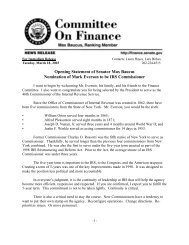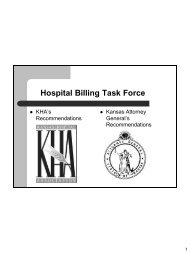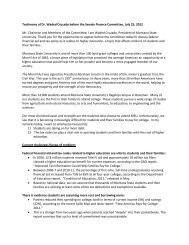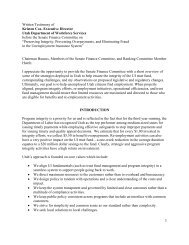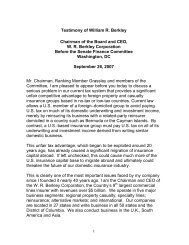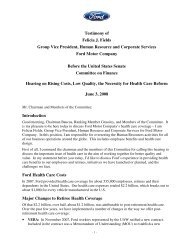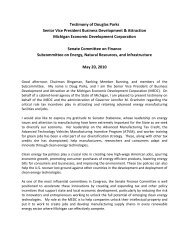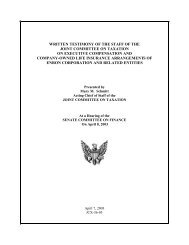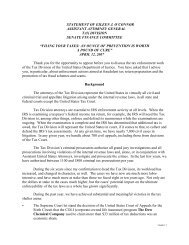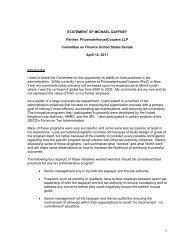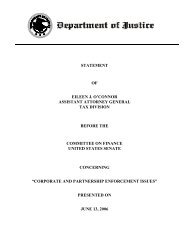Testimony - Senate Finance Committee
Testimony - Senate Finance Committee
Testimony - Senate Finance Committee
Create successful ePaper yourself
Turn your PDF publications into a flip-book with our unique Google optimized e-Paper software.
<strong>Testimony</strong>: Ric Edelman<br />
Hearing: “Building Assets for Low-Income Families”<br />
Hearing Date: April 28, 2005<br />
I am honored to present testimony today before the Subcommittee on Social Security and<br />
Family Policy of the <strong>Senate</strong> <strong>Committee</strong> on <strong>Finance</strong>.<br />
In short, the ASPIRE Act is a brilliant idea, and I highly commend Senators Rick<br />
Santorum and Jon Corzine for sponsoring this legislation. I can say that this idea is brilliant<br />
because I had the same idea – and brilliant minds think alike. I also get to brag that I thought of it<br />
first, although yours is an improvement in several important ways. Let me explain.<br />
I am a financial advisor and founder of Edelman Financial Services, the largest<br />
independent financial planning firm in the nation, based on number of clients, according to<br />
Bloomberg Wealth Manager. My firm manages more than $2.6 billion in client assets for more<br />
than 7,000 individuals and families. Unlike the vast majority of advisors, my firm does not work<br />
primarily with the high-net worth market. Instead, we cater to middle class families who want to<br />
achieve financial and retirement security.<br />
I also host radio and television programs on personal finance, and I have written 5 books,<br />
including 3 national best-sellers which collectively have sold more than 1 million copies. I also<br />
host a financial education web site, www.ricedelman.com, publish a monthly newsletter and am<br />
very active in financial literacy activities.<br />
Several years ago, I invented the RIC-E Trust® - the Retirement InCome – for Everyone<br />
Trust®. This is a retirement planning tool for children that is so unique it has two U.S. patents<br />
(6,064,986 and 6,085,174). So far, approximately 2,800 RIC-E (pronounced RICKY) Trusts®<br />
have been created.<br />
The idea was inspired several years ago by a caller to my radio show. He said his wife<br />
had just delivered a baby and he wanted to save for this new son’s future. When I began<br />
explaining how best to save for college, he interrupted me. “I’m not talking about college,” he<br />
said. “I want to know how to save for his retirement.”<br />
I was stunned – and told him so. “Nobody saves for a baby’s retirement!” I exclaimed.<br />
The entire notion is preposterous – we all know how hard it is to save for college – can you<br />
imagine the cost of saving for a baby’s retirement!?!?<br />
To prove my point to him – while still on the air – I pulled my financial calculator from<br />
my briefcase and quickly punched in a formula. If you set aside $5,000 at birth and leave the<br />
money untouched until the baby is 18 and ready for college, assuming a 10% annual return (the<br />
average annual return of the S&P 500 Stock Index since 1926 is 10.4%, according to Ibbotson<br />
Associates), you’ll accumulate about $27,000. That’s not enough to pay for college today, let<br />
alone 18 years from now.<br />
Page 1 of 4
But that same $5,000, at the same 10% return, if left invested for 65 years, would grow to<br />
$2.4 million!<br />
Contrast that with the experience of a hardworking American who dutifully saves in a<br />
401(k) plan for an entire career. Even if a worker saves 10% of pay every year from age 20 to<br />
age 65, and even if that worker chooses the right investments the entire time, that account will be<br />
worth – if the worker is lucky – only about $750,000. By comparison, a one-time contribution of<br />
just $5,000 produces more than three times as much!<br />
The reason, of course, is the magic of compound interest. Never before has anyone tried<br />
to grow money for such a long period of time. Yet, that’s the key to retirement security.<br />
Unfortunately, there are two problems with my simple math, and I explained them to my<br />
caller. First, my calculation did not adjust for taxes. If you have to pay taxes annually on the<br />
account’s profits, you won’t end up with $2.4 million. Instead, assuming a 33% tax rate, you’ll<br />
accumulate only less than $350,000 – rending the value of the effort hardly worthwhile. Second,<br />
if you set aside money for a child, the child at age 18 gets legal access to that money – so the real<br />
question is not wondering what the account balance will be at age 65 but, rather, what color the<br />
sports car will be when the child graduates high school. Indeed, based on my nearly 20 years of<br />
experience counseling thousands of families, I can assure you that if the child can spend the<br />
money, he or she will.<br />
Even if the child refrains from a frivolous splurge, it is still unlikely that the account will<br />
survive intact all the way to retirement. Why? Because we all encounter financial issues during<br />
our adult lives – the need for a down payment to buy a house, large unexpected medical bills,<br />
sudden job loss, marital or family problems and more. Being able to tap into an account often is<br />
too tempting to resist. Only later, in retirement, do people express regret.<br />
So, the harsh realities of taxes and access burst the bubble of the idea. But I was<br />
convinced there was a solution, and that finding a solution could translate into a huge benefit, not<br />
only for America’s babies, but for the next generation and, by extension, all of American society.<br />
It took me two years to overcome the tax and legal hurdles these problems presented, but<br />
I succeeded and as a result the RIC-E Trust® was introduced in 1998. Although designed for<br />
newborns, a RIC-E Trust® can be created for anyone of any age (although, obviously, the<br />
younger the beneficiary and the later the benefits are received, the more the account can grow).<br />
The trust is irrevocable, meaning that money contributed cannot be accessed until the beneficiary<br />
(the child) reaches retirement age (which is set by the grantor upon creation of the trust; it cannot<br />
later be changed and cannot be less than age 59½). There are exceptions for the child’s disability<br />
(he or his parent/guardian gets the money) or death (his estate gets the money for distribution to<br />
heirs). This solves the access problem.<br />
To solve the tax problem, the trust invests the money in a variable annuity, which allows<br />
the money to grow tax-deferred until withdrawal. This allows for tax-free compounding over<br />
Ric Edelman 4-28-05 “Building Assets for Low-Income Families” www.ricedelman.com<br />
Page 2 of 4
decades, just like an IRA. The money can be invested in a wide range of asset classes – stocks,<br />
bonds, government securities, real estate funds and more.<br />
There is a one-time set-up fee of $300 to establish a RIC-E Trust®, and there are the<br />
typical fees charged by annuities. There are no other expenses – no annual fees, no custodian or<br />
trustee fees, and no annual income tax, nor any tax reporting or preparation. The minimum<br />
investment is $5,000 and additional contributions can be made at any time in amounts of $500 or<br />
more. But other than voluntarily adding money to the account, the RIC-E Trust®, once<br />
established, is completely hands-off. Time will do the rest, with quarterly statements issued to<br />
the child and grantor.<br />
The program envisioned by the ASPIRE Act is much better than my RIC-E Trust® for<br />
two reasons: first, it is automatic for every child in America; mine requires decisive action by<br />
parents and grandparents, and of course requires them to have financial ability to contribute<br />
$5,000 for each of their family’s children and grandchildren. This puts the RIC-E Trust® beyond<br />
the reach of the vast majority of Americans. Second, if the ASPIRE Act operates similarly to the<br />
federal Thrift Savings Plan, the operating expenses would be extremely low – much lower than<br />
those of private-sector variable annuities like the one my RIC-E Trust® uses. These lower costs<br />
can translate to higher account values for the children.<br />
I have only two concerns with the ASPIRE proposal. First, I would prefer that the<br />
account be restricted to retirement. Currently, it also can be used for education and buying a<br />
home. This is not necessary: with the advent of student loans and mortgages, both college and<br />
home ownership have become pay-as-you-go expenses. Nobody pays cash for a home anymore.<br />
Instead, they pay for it while they live in it – if they move, they sell the home and use the<br />
proceeds to pay off the mortgage. Similarly, nobody needs to pay for college up-front anymore.<br />
Instead, students can get through school via loans, and then repay those loans over the course of<br />
their 40-year careers. This is not only an acceptable approach, it is increasingly the only<br />
approach that is viable for today’s college students.<br />
But you cannot pay for retirement on a pay-as-you-go basis; it is the one major expense<br />
that must be paid for in advance. After all, you can’t save for retirement while you’re in<br />
retirement, and for that reason, I recommend that the ASPIRE Act restrict distributions to<br />
retirement age, with exceptions for death and disability. Otherwise, we face the risk that many<br />
will spend the proceeds long before they reach retirement age.<br />
Second, since the proposal already permits Americans to make additional voluntary<br />
contributions, I would recommend that these limits be increased. While the program should not<br />
become a tax shelter for the rich, raising the ceiling to the RIC-E Trust®’s level of $5,000 would<br />
be of value to middle class and upper middle class families, and would result in larger numbers<br />
of Americans being able to reach retirement age with a higher degree of retirement security.<br />
This, in turn, would reduce their dependency on government in their elder years, freeing the<br />
government to focus its resources on other important needs.<br />
Ric Edelman 4-28-05 “Building Assets for Low-Income Families” www.ricedelman.com<br />
Page 3 of 4
I fully realize that the establishment of accounts under the ASPIRE Act would put my<br />
RIC-E Trust® out of business, rendering it both redundant and more expensive than the ASPIRE<br />
Act’s federally sponsored version. This would cause me economic harm.<br />
Go ahead and do it. It’s the right thing to do for Americans, and for America. And I will<br />
do everything I can to support this initiative and help it become law.<br />
Related website: http://www.ricetrust.com<br />
Ric Edelman 4-28-05 “Building Assets for Low-Income Families” www.ricedelman.com<br />
Page 4 of 4



